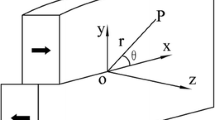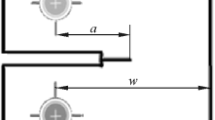Summary
The experimental method of reflected causties was extended in this paper for the study of the strength of the plastic singularity and the respective plastic stress intensity factor at the tip of a mode-I crack in an elastic-strain hardening material. The elastic-plastic field around the crack tip was defined by means of the singular plastic solutions of Hutchinson, Rice and Rosengren (HRR-asymptotic field) which gives satisfactory results for small scale yielding types of deformation. The initial curve, generating the caustic by reflection from the front face of the deformed specimen lying well within the plastic zone, was accurately determined by considering the contribution of the elastic and plastic components of stresses and strains within the plastic zone.
Results with experiments executed on steel specimens single-edge notched with various values of the hardening exponentn coincided with the form and shape of the theoretically derived caustics thus confirming the validity of the developed theory. The values of the plastic stress intensity factor thus derived corroborated the already existing results from previous experiments.
Similar content being viewed by others
References
McClintok, F. A., Irwin, G. R.: Fracture toughness testing and its applications. ASTM-STP381, 84–113 (1965).
Willis, J. R.: Crack propagation in viscoelastic media. J. Mech. Phys. Solids15, 229–240 (1967).
Rice, J. R.: Mathematical analysis in the mechanics of fracture. In: Fracture: an advanced treatise (Liebowitz, H., ed.), vol. II, pp. 191–311. New York: Academic Press 1968.
Rice, J. R., Rosengren, G. F.: Plane strain deformation near a crack tip in a power law hardening material. J. Mech. Phys. Solids16, 1–12 (1968).
Hutchinson, J. W.: Singular behaviour at the end of a tensile crack in a hardening material. J. Mech. Phys. Solids16, 13–31 (1968).
Hutchinson, J. W.: Plastic stress and strain fields at a crack tip. J. Mech. Phys. Solids16, 337–347 (1968).
Hilton, P. D., Hutchinson, J. W.: Plastic intensity factors for cracked plates. Eng. Fract. Mech.3, 435–451 (1971).
Amazigo, J. C., Hutchinson, J. W.: Crack-tip fields in steady crack growth with linear strain hardening. J. Mech. Phys. Solids25, 81–97 (1977).
Edmunds, T. M., Willis, J. R.: Matched asymptotic expansions in nonlinear fracture mechanics-III. In-plane loading of an elastic perfectly-plastic symmetric specimen. J. Mech. Phys. Solids25, 423–455 (1977).
Rice, J. R., Sorensen, E. P.: Continuing crack-tip deformation and fracture from plane strain crack growth in elastic-plastic solids. J. Mech. Phys. Solids26, 163–186 (1978).
Begley, J. A., Landes, J. D.: Serendipity and theJ-integral. Int. J. Fracture12, R764-R766 (1976).
Begley, J. A., Landes, J. D.: TheJ-integral as a fracture criterion. Fracture toughness. In: The 1971 National Symposium of Fracture Mechanics, Part II, ASTM STP515, 1–20 (1972).
Green, G., Knott, J. F.: On effects of thickness on ductile crack growth in mild steel. J. Mech. Phys. Solids23, 167–183 (1975).
Theocaris, P. S.: Experimental solution of elastic-plastic plane-stress problems. J. Appl. Mech.29, 735–743 (1962).
Theocaris, P. S.: Combined photoelastic and electrical analog method for the solution of plane-stress plasticity problems. Exp. Mech.3 (9), 207–214 (1963).
Theocaris, P. S.: The effect of plasticity on the stress distribution of thin notched plates in tension. J. Franklin Inst.279, 22–38 (1965).
Theocaris, P. S., Marketos, E.: Elastic-plastic strain and stress distribution in notched plates under plane stress. J. Mech. Phys. Solids11, 411–428 (1963).
Shih, C. F.: Small-scale yielding analysis of mixed-mode plane-strain crack problems. ASTM Spec. Techn. Publ.560, 187–210 (1974).
Rice, J. R.: Stresses due to a sharp notch in a work-hardening elastic-plastic material loaded by longitudinal shear. J. Appl. Mech.28, 287–298 (1967).
Theocaris, P. S., Razem, C. I.: Plastic stress intensity factors for small-scale yielding in antiplane shear by caustics. J. Appl. Mech.49, 754–760 (1982).
Theocaris, P. S., Philippides, Th.: Plastic stress intensity factors in out-of-plane shear by reflected caustics. Engng. Fract. Mech.27 (3), 299–314 (1987).
Theocaris, P. S.: Experimental evaluation of the plastic zones for steady mode-III crack growth. Acta Mechanica69, 271–294 (1987).
Rosakis, A. J., Ma, C. C., Freund, L. B.: Analysis of the optical shadow-spot method for a tensile crack in a power-law hardening material. J. Appl. Mech.50, 777–782 (1983).
Rice, J. R., Johnson, M. A.: The role of large crack-tip geometry changes in plane-stress fracture. In: Inelastic behavior of solids (Kanninen, M. F., et al., eds.), pp. 641–672. New York: McGraw-Hill 1970.
Theocaris, P. S.: Blunting phenomena in cracked ductile plates under mixed mode conditions. Engng. Fract. Mech.31 (2), 255–270 (1988).
Shih, C. F., German, M. D.: Requirement for a one-parameter characterization of crack-tip fields by the HRR singularity. Int. J. Fract.17 (1), 27–43 (1981).
Theocaris, P. S., Marketos, E.: Elastic-plastic analysis of perforated thin strips of a strain hardening material. J. Mech. Phys. Solids12 (4), 377–390 (1964).
Fox, L.: Numerical solutions of ordinary and partial differential equations, p. 83 (§24). Oxford: Pergamon Press 1962.
Theocaris, P. S.: Elastic stress intensity factors evaluated by caustics. In: Experimental determination of crack-tip stress intensity factors. (Sih, G. C., ed.)7, pp. 189–252. The Hague: Martinus Nijhof 1979.
Theocaris, P. S., Philippides, T. P.: Possibilities of reflected caustics due to an improved optical arrangement: some further aspects. Appl. Optics23 (20), 3667–3675 (1984).
Theocaris, P. S., Koroneos, E.: Stress-strain and contraction ratio curves for polycrystalline steel. Philosophical Magazine8 (95), 1871–1893 (1963).
Theocaris, P. S.: Moiré fringes in strain analysis. London: Pergamon Press 1969.
Theocaris, P. S., Gdoutos, E.: Verification of the validity of the Dugdale-Barenblatt model by the method of caustics. Engng. Fract. Mech.6, 523–525 (1974).
Theocaris, P. S.: Ductile fracture in glassy polymers. Int. J. Mech. Sci.17, 475–485 (1975).
Author information
Authors and Affiliations
Rights and permissions
About this article
Cite this article
Theocaris, P.S. Stress intensities in elastic-plastic plane-stress fields by caustics. Acta Mechanica 87, 219–238 (1991). https://doi.org/10.1007/BF01299796
Received:
Issue Date:
DOI: https://doi.org/10.1007/BF01299796




